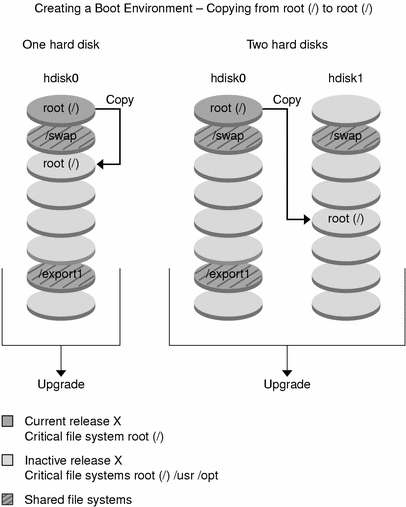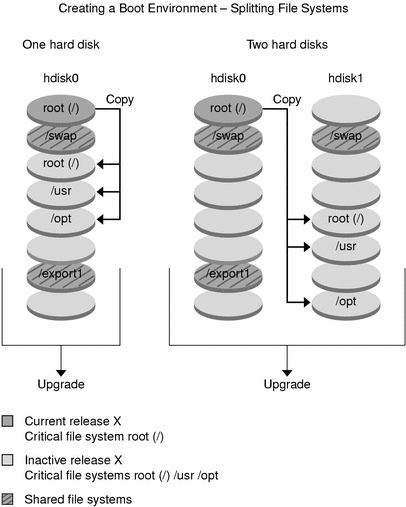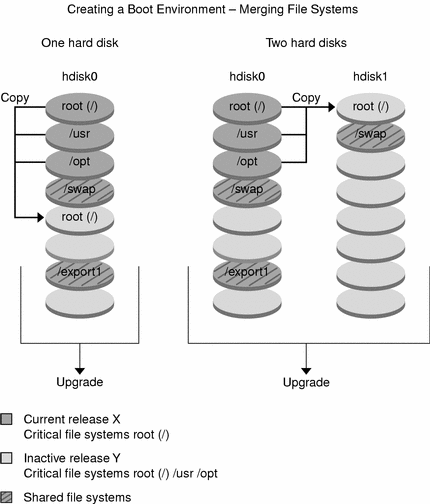Creating a Boot Environment
The process of creating a boot environment provides a method of copying critical file systems from an active boot environment to a new boot environment. The disk is reorganized if necessary, file systems are customized, and the critical file systems are copied to the new boot environment.
File System Types
Solaris Live Upgrade distinguishes between two file system types: critical file systems and shareable file systems. Critical file systems are required by the Solaris operating environment. These file systems are separate mount points in the vfstab of the active and inactive boot environments. Examples are root (/), /usr, /var, or /opt. These file systems are always copied from the source to the inactive boot environment. Critical file systems are sometimes referred to as non-shareable. Shareable file systems are user-defined files such as /export that contain the same mount point in the vfstab in both the active and inactive boot environments. Therefore, updating shared files in the active boot environment also updates data in the inactive boot environment. When you create a new boot environment, shareable file systems are shared by default. But you can specify a destination slice and then the file systems are copied. For more detailed information about shareable file systems, see Guidelines for Selecting Slices for Shareable File Systems.
Swap is a special shareable file system. Like a shareable file system, all swap slices are shared by default. But, if you specify a destination directory for swap, the swap slice is copied. For procedures on reconfiguring swap, see the following:
-
“To Create a Boot Environment (Character Interface)” Step 9
-
To Create a Boot Environment and Reconfigure Swap (Command-Line Interface)
Solaris Live Upgrade can create a boot environment with RAID-1 volumes (mirrors) on file systems. For an overview, see Creating a Boot Environment With Mirrored File Systems.
Copying File Systems
The process of creating a new boot environment begins by identifying an unused slice where a critical file system can be copied. If a slice is not available or a slice does not meet the minimum requirements, you need to format a new slice.
After the slice is defined, you can reconfigure the file systems on the new boot environment before the file systems are copied into the directories. You reconfigure file systems by splitting and merging them, which provides a simple way of editing the vfstab to connect and disconnect file system directories. You can merge file systems into their parent directories by specifying the same mount point. You can also split file systems from their parent directories by specifying different mount points.
After file systems are configured on the inactive boot environment, you begin the automatic copy. Critical file systems are copied to the designated directories. Shareable file systems are not copied, but are shared. The exception is that you can designate some shareable file systems to be copied. When the file systems are copied from the active to the inactive boot environment, the files are directed to the new directories. The active boot environment is not changed in any way.
-
For procedures about splitting and merging file systems, see the following procedures:
-
“To Create a Boot Environment (Character Interface)” Step 7 or Step 8
-
To Create a Boot Environment and Split File Systems (Command-Line Interface)
-
-
For an overview of creating a boot environment with mirrored file systems, see Creating a Boot Environment With Mirrored File Systems.
The following figures illustrate various ways of creating new boot environments.
Figure 30–1 shows that critical file system root (/) has been copied to another slice on a disk to create a new boot environment. The active boot environment contains root (/) on one slice. The new boot environment is an exact duplicate with root (/) on a new slice. The file systems /swap and /export/home are shared by the active and inactive boot environments.
Figure 30–1 Creating an Inactive Boot Environment - Copying root (/) to root (/)

Figure 30–2 shows critical file systems that have been split and have been copied to slices on a disk to create a new boot environment. The active boot environment contains root (/) on one slice. On that slice, root (/) contains the /usr, /var, and /opt directories. In the new boot environment, root (/) is split and /usr and /opt are put on separate slices. The file systems /swap and /export/home are shared by both boot environments.
Figure 30–2 Creating an Inactive Boot Environment - Splitting File Systems

Figure 30–3 shows critical file systems that have been merged and have been copied to slices on a disk to create a new boot environment. The active boot environment contains root (/), /usr, /var, and /opt with each file system on their own slice. In the new boot environment, /usr and /opt are merged into root (/) on one slice. The file systems /swap and /export/home are shared by both boot environments.
Figure 30–3 Creating an Inactive Boot Environment - Merging File Systems

- © 2010, Oracle Corporation and/or its affiliates
